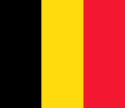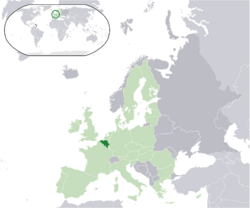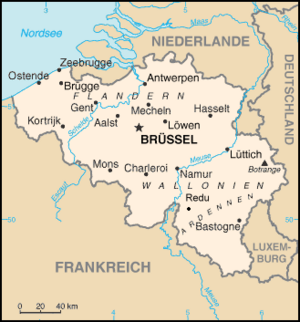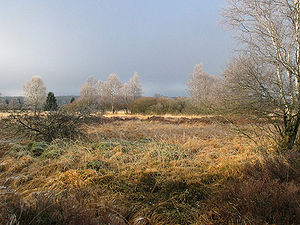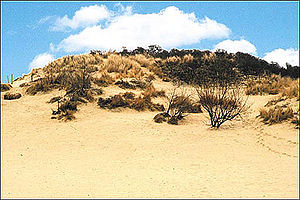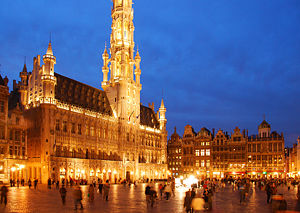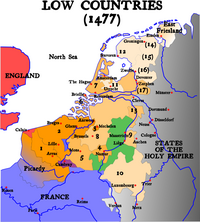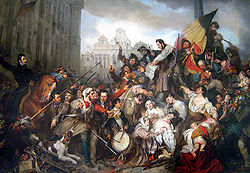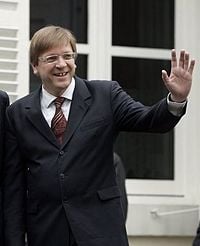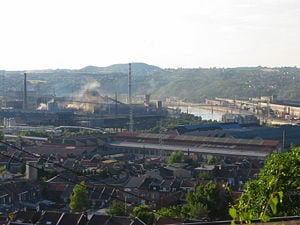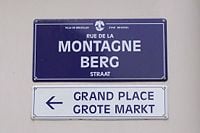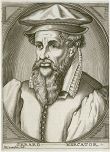Difference between revisions of "Belgium" - New World Encyclopedia
Mike Butler (talk | contribs) |
Mike Butler (talk | contribs) |
||
| Line 155: | Line 155: | ||
==Government and politics== | ==Government and politics== | ||
| − | [[Image: | + | [[Image:Brussel Parlementsgebouw.jpg|thumb|left|300px|The Palace of the Nation in [[Brussels]], the seat of the Belgian Federal Parliament.]] |
| − | + | [[Image:Hemisphere Debate 50 Years Europe.JPG|thumb|300px|left|The chamber of the Belgian Senate.]] | |
| − | |||
| − | |||
| − | |||
===Constitutional structure=== | ===Constitutional structure=== | ||
Belgium is a [[constitutional monarchy|constitutional]], [[popular monarchy]] and a [[parliamentary system|parliamentary democracy]]. | Belgium is a [[constitutional monarchy|constitutional]], [[popular monarchy]] and a [[parliamentary system|parliamentary democracy]]. | ||
| Line 169: | Line 166: | ||
The bicameral Parliament consists of a Senate of 71 members, 40 of whom are directly elected by popular vote and 31 indirectly elected, to serve four-year terms, and a Chamber of Deputies of 150 members who are directly elected by popular vote on the basis of proportional representation to serve four-year terms. Suffrage is universal to those aged 18 years and over. Voting is compulsory so more than 90 percent of the population participates. | The bicameral Parliament consists of a Senate of 71 members, 40 of whom are directly elected by popular vote and 31 indirectly elected, to serve four-year terms, and a Chamber of Deputies of 150 members who are directly elected by popular vote on the basis of proportional representation to serve four-year terms. Suffrage is universal to those aged 18 years and over. Voting is compulsory so more than 90 percent of the population participates. | ||
| − | + | Belgium is a federation with a [[multi-party]] political system, with numerous parties have no chance of gaining power alone, and therefore must work with each other to form [[coalition government]]s. Almost all Belgian political parties are divided into linguistic groups, either [[Dutch language|Dutch]]-speaking parties, [[Francophone]] parties, or germanophone parties. The Flemish parties operate in [[Flanders]] and in the [[Brussels-Capital Region]]. The Francophone parties operate in [[Wallonia]] and in the Brussels-Capital Region. There are also parties operating in the comparatively small [[German-speaking community of Belgium|German-speaking community]]. | |
| + | |||
| + | Political parties are thus organised along community lines, especially for the three main communities. There are no representative parties active in both communities. Even in [[Brussels]], all parties presenting candidates are either Flemish parties, or French-speaking. As such, the internal organisation of the political parties reflects the fundamentally dual nature of Belgian society. There are no significant parties left who exist, or operate on a national, Belgian level. | ||
| − | Belgium | + | From the creation of the Belgian state in 1830 and throughout most of the nineteenth century, two political parties dominated Belgian politics: the [[Catholic Party (Belgium)|Catholic Party]] (Church-oriented and [[conservatism|conservative]]) and the [[Liberal Party (Belgium)|Liberal Party]] ([[anti-clericalism|anti-clerical]] and [[progressivism|progressive]]). In the late nineteenth century the [[Parti Ouvrier Belge |Labour Party]] arose to represent the emerging industrial working class. |
| − | Belgium's three principal trade union organizations are the [[Confederation of Christian Trade Unions]] | + | Belgium is a highly [[trade union|unionised]] country, and organised labour is a powerful influence in politics. About 53 percent of all private sector and public service employees are labour union members. Not simply a "bread and butter" movement in the American sense, Belgian labour unions take positions on education, public finance, defence spending, environmental protection, women's rights, [[abortion]], and other issues. They also provide a range of services, including the administration of unemployment benefits. Belgium's three principal trade union organizations are the [[Confederation of Christian Trade Unions]] (1,705,000 members), the [[General Federation of Belgian Labour]] (1,198,000 members) and the [[General Confederation of Liberal Trade Unions of Belgium]] which has 230,000 members. |
The [[Court of Appeals]] is one level below the [[Court of Cassation (Belgium)|Court of Cassation]], an institution based on the [[Court of Cassation (France)|French Court of Cassation]]. The [[Court of Cassation (Belgium)|Court of Cassation]] is the most important court in Belgium. Judges are appointed for life by the Belgian monarch. The judicial system is based on [[Civil law (legal system)|civil law]] and originates from the [[Napoleonic code]]. It has a judicial review of legislative acts. It accepts compulsory [[International Court of Justice|ICJ]] jurisdiction, with reservations. | The [[Court of Appeals]] is one level below the [[Court of Cassation (Belgium)|Court of Cassation]], an institution based on the [[Court of Cassation (France)|French Court of Cassation]]. The [[Court of Cassation (Belgium)|Court of Cassation]] is the most important court in Belgium. Judges are appointed for life by the Belgian monarch. The judicial system is based on [[Civil law (legal system)|civil law]] and originates from the [[Napoleonic code]]. It has a judicial review of legislative acts. It accepts compulsory [[International Court of Justice|ICJ]] jurisdiction, with reservations. | ||
| − | + | ===Political crisis=== | |
| − | + | [[Image:Belgian prime minister Guy Verhofstadt.jpg|thumb|200px|right|[[Guy Verhofstadt]], Prime Minister of mainly Liberal - Social Democrat governments for two full terms.]] | |
| − | + | A string of Christian Democrat coalition governments from 1958 was broken in [[Belgian general election, 1999|1999]] after the first [[dioxin]] crisis, a major food contamination scandal which led to the establishment of the Belgian Food Agency. The government led by Prime Minister [[Guy Verhofstadt]] from 1999 to 2007 achieved a balanced budget, some tax-reforms, a labour-market reform, scheduled [[Nuclear energy policy#Europe|nuclear phase-out]], and instigated legislation allowing more stringent [[War Crimes Law (Belgium)|war crime]] and more lenient [[soft drugs|soft drug usage]] prosecution. Restrictions on withholding [[euthanasia#Belgium|euthanasia]] were reduced and [[same-sex marriage in Belgium|same-sex marriage]] legalized. The government promoted active diplomacy in Africa. Verhofstadt's coalition fared badly in the [[Belgian general election, 2007|elections of 2007]]. Since then, as of November 2007, the country has been experiencing a long lasting [[2007 Belgian government formation |political crisis]]. This crisis is such that many observers have speculated a possible [[partition of Belgium]]. | |
| − | |||
| − | |||
| − | |||
| − | |||
| − | |||
| − | |||
| − | |||
| − | A string of Christian Democrat coalition governments from 1958 was broken in [[Belgian general election, 1999|1999]] after the first [[dioxin]] crisis, a major food contamination scandal which led to the establishment of the Belgian Food Agency. | ||
| − | |||
| − | |||
| − | |||
| − | |||
| − | |||
| − | |||
| − | |||
| − | |||
| − | |||
| − | |||
| − | |||
| − | |||
| − | |||
| − | |||
| − | |||
| − | |||
| − | |||
| − | |||
| − | |||
| − | |||
| − | |||
| − | |||
| − | |||
| − | |||
| − | |||
| − | |||
| − | |||
| − | |||
| − | |||
| − | |||
| − | |||
| − | |||
| − | |||
| − | |||
| − | |||
| − | |||
| − | |||
| − | |||
| − | |||
| − | |||
In its 2007 Worldwide Press Freedom Index, [[Reporters Without Borders]] ranked Belgium (along with [[Finland]] and [[Sweden]]) 5th out of 169 countries. | In its 2007 Worldwide Press Freedom Index, [[Reporters Without Borders]] ranked Belgium (along with [[Finland]] and [[Sweden]]) 5th out of 169 countries. | ||
| − | = | + | ===Language a political issue=== |
| − | + | Belgium is a country where language is a major political issue. Despite the numerous constitution revisions, the matter is not completely settled. There is still a lot of political tension between French-speakers and Dutch-speakers, and, to a lesser degree, between French-speakers and the politically far weaker German-speakers. Flemings also complain about remaining discriminations (like the fact Walloon candidates can obtain votes from voters in both Flemish and Walloon regions, but that is impossible for a Flemish candidate). | |
| − | |||
| − | |||
| − | |||
| − | |||
| − | |||
| − | |||
| − | |||
| − | |||
| − | |||
| − | |||
| − | |||
| − | |||
| − | |||
| − | |||
| − | |||
| − | |||
| − | |||
| − | |||
| − | |||
| − | |||
| − | |||
| − | |||
| − | |||
| − | |||
| − | |||
| − | |||
| − | |||
| − | |||
| − | |||
| − | |||
| − | |||
| − | |||
| − | |||
| − | |||
| − | |||
| − | |||
| − | |||
| − | |||
| − | |||
| − | |||
| − | |||
| − | |||
| − | |||
| − | |||
| − | |||
| − | |||
| − | |||
| − | |||
| − | |||
| − | |||
| − | |||
| − | |||
| − | |||
| − | |||
| − | |||
| − | |||
| − | |||
| − | |||
| − | |||
| − | |||
| − | |||
| − | |||
| − | |||
| − | |||
| − | |||
| − | + | ===Political authority=== | |
| − | + | The Federal State retains a considerable "common heritage". This includes justice, defense, federal police, social security, nuclear energy, monetary policy and public debt, and other aspects of public finances. State-owned companies include the Post Office and [[Rail transport in Belgium|Belgian Railways]]. The Federal Government is responsible for the obligations of Belgium and its federalized institutions towards the European Union and NATO. It controls substantial parts of public health, home affairs and foreign affairs. | |
| − | |||
| − | |||
| − | |||
| − | |||
| − | |||
| − | |||
| − | |||
| − | |||
| − | |||
| − | |||
| − | |||
| − | |||
| − | |||
| − | |||
| − | |||
| − | |||
| − | |||
| − | |||
| − | |||
| − | |||
| − | |||
| − | |||
| − | |||
| − | |||
| − | |||
| − | |||
| − | |||
| − | |||
| − | |||
| − | + | Communities exercise their authority only within linguistically determined geographical boundaries, originally oriented towards the individuals of a Community's language: culture (including audiovisual media), education, and the use of the relevant language. Extensions to personal matters less directly connected with language comprise health policy (curative and preventive medicine) and assistance to individuals (protection of youth, social welfare, aid to families, immigrant assistance services, etc.). | |
| − | |||
| − | |||
| − | |||
| − | |||
| − | |||
| − | |||
| − | |||
| − | |||
| − | |||
| − | + | Regions have authority in fields that can be broadly associated with their territory. These include economy, employment, agriculture, water policy, housing, public works, energy, transport, the environment, town and country planning, nature conservation, credit, and foreign trade. They supervise the provinces, municipalities, and intercommunal utility companies. | |
| − | |||
| − | |||
| − | |||
| − | |||
| − | |||
| − | |||
| − | + | In several fields, the different levels each have their own say on specifics. With education, for instance, the autonomy of the Communities neither includes decisions about the compulsory aspect nor allows for setting minimum requirements for awarding qualifications, which remain federal matters.<ref name=fedgov1/> Each level of government can be involved in scientific research and international relations associated with its powers. | |
| − | |||
| − | |||
| − | |||
| − | |||
| − | |||
| − | |||
| − | + | ===Military=== | |
| + | The Belgian Armed Forces have about 41,000 active troops. They are organised into one unified structure which consists of four main components: The [[Army]], the [[Air Force]], the [[Navy]], and the Medical Component. | ||
Revision as of 23:50, 22 November 2007
| (Dutch) Koninkrijk België (French) Royaume de Belgique (German) Königreich Belgien Kingdom of Belgium | |||||
| |||||
| Motto: Eendracht maakt macht (Dutch) L'union fait la force" (French) Einigkeit macht stark (German) "Strength through Unity" | |||||
| Anthem: The "Brabançonne" | |||||
|
Location of Belgium (dark green)
– on the European continent (light green dark grey) – in the European Union (light green) | |||||
| Capital | Brussels 50°54′N 4°32′E | ||||
|---|---|---|---|---|---|
| Official languages | Dutch, French, German | ||||
| Government | Federal constitutional monarchy and bicameral parliamentary democracy | ||||
| - King | Albert II | ||||
| - Prime Minister | Guy Verhofstadt | ||||
| Independence | |||||
| - Declared | 4 October 1830 | ||||
| - Recognized | 19 April 1839 | ||||
| Accession to EU | 25 March 1957 | ||||
| Area | |||||
| - Total | 30,528 km² (139th) 11,787 sq mi | ||||
| - Water (%) | 6.4 | ||||
| Population | |||||
| - 2007 estimate | 10,584,534[1] | ||||
| - 2001 census | 10,296,350 | ||||
| - Density | 344.32/km² 892/sq mi | ||||
| GDP (PPP) | 2004 estimate | ||||
| - Total | $316.2 billion | ||||
| - Per capita | $31,400 | ||||
| HDI (2004) | |||||
| Currency | Euro (€)1 (EUR)
| ||||
| Time zone | CET (UTC+1) | ||||
| - Summer (DST) | CEST (UTC+2) | ||||
| Internet TLD | .be² | ||||
| Calling code | +32 | ||||
The Kingdom of Belgium is a country in northwest Europe bordered by the Netherlands, Germany, Luxembourg, and France, with a short coastline on the North Sea.
Straddling the cultural boundary between Germanic and Latin Europe, Belgium's two largest regions are Dutch-speaking Flanders in the north, with 58 percent of the population, and the French-speaking southern region of Wallonia, inhabited by 32 percent.
The Brussels-Capital Region is an officially bilingual enclave within the Flemish and near the Walloon Region, and has 10 percent of the population.
Historically, Belgium, the Netherlands and Luxembourg were known as the Low Countries, which used to cover a somewhat larger area than the current Benelux group of states. From the end of the Middle Ages until the seventeenth century, it was a prosperous centre of commerce and culture. From the sixteenth century until the Belgian revolution in 1830, many battles between European powers were fought in the area of Belgium, causing it to be dubbed "the battlefield of Europe" – a reputation strengthened by both World Wars. Upon its independence, Belgium eagerly participated in the Industrial Revolution, generating wealth and also a demand for raw materials; the latter was a factor during the era of its African colonies.
Geography
The name "Belgium" is derived from Gallia Belgica, a Roman province in the northernmost part of Gaul that was inhabited by the Belgae, a mix of Celtic and Germanic
Belgium shares borders with France, Germany, Luxembourg, and the Netherlands, and covers an area of 11,787 square miles (30,528 square kilometers), which is about the size of the state of Maryland in the United States.
Belgium is a low-lying country, with a broad coastal plain extending to the south-east from the North Sea and The Netherlands and rising gradually into the Ardennes hills and forests of the southeast, on which the Signal de Botrange forms the country's highest point at 2277 feet (694 meters).
Belgium has three main geographical regions: the coastal plain in the north-west, the central plateau, and the Ardennes uplands in the south-east. The coastal plain consists mainly of sand dunes and polders. Polders are areas of land, close to or below sea level that have been reclaimed from the sea, from which they are protected by dikes or, further inland, by fields that have been drained with canals. The second geographical region, the central plateau, lies further inland. This is a smooth, slowly rising area that has many fertile valleys and is irrigated by many waterways. Here one can also find rougher land, including caves and small gorges.
The climate is maritime temperate, with significant precipitation in all seasons. The average temperature is lowest in January (winter) at 37°F (3°C) and highest in July (summer) at 64°F (18°C) The average precipitation per month varies between 2.1 inches (54mm) in February or April, to 3.1 in (78mm) in July.
The low-lying plain of Flanders is drained by the Leie, Schelde, and Dender rivers flowing northeast to the Schelde estuary, plus several shipping canals. The Ardennes is a plateau cut into by the Meuse River and its tributaries.
Natural resources include construction materials, silica sand, and carbonates.
Belgium's flora includes digitalis, wild arum, hyacinth, strawberry, goldenrod, lily of the valley, and other plants common to temperate zones, while beech and oak are the predominant trees. Boar, fox, badger, squirrel, weasel, marten, and hedgehog are still found in Belgium. Aquatic life includes pike, carp, trout, eel, barbel, perch, smelt, chub, roach, bream, shad, sole, mussels, crayfish, and shrimp.
Flooding is a threat along rivers and in areas of reclaimed coastal land, protected from the sea by concrete dikes.
The environment is under intense pressure from human activities, including urbanization, a dense transportation network, industry, extensive animal breeding, and crop cultivation. Air and water pollution have repercussions for neighboring countries. Uncertainties regarding federal and regional responsibilities have slowed progress in tackling environmental challenges.
Brussels is the capital of Belgium and it is the headquarters of most of the European Union's institutions. The metropolitan area had between 2.1 to 2.6 million people in 2006.
History
The area of present-day Belgium has seen significant demographic, political and cultural upheavals over the course of two millenia. In the first century, the Romans, after defeating the local tribes, created the province of Gallia Belgica. A gradual immigration by Germanic Frankish tribes during the fifth century, brought the area under the rule of the Merovingian kingdom, which evolved into the Carolingian Empire in the eighth century. During the Middle Ages small feudal states emerged, many of which rejoined as the Burgundian Netherlands in the fourteenth and fifteenth centuries. Emperor Charles V completed the union of the Seventeen Provinces in the 1540s, and unofficially also controlled the Prince-Bishopric of Liège.[2]
The Eighty Years' War (1568–1648) divided the area into the northern United Provinces ('federate' Belgica Foederata in Latin) and the Southern Netherlands ('royal' Belgica Regia). The latter were ruled successively by the Spanish and the Austrian Habsburgs and comprised most of modern Belgium. Until independence the area was sought after by numerous French conquerors and was the theatre of most Franco-Spanish and Franco-Austrian wars during the seventeenth and eighteenth centuries.[3] Following the campaigns of 1794 in the French Revolutionary Wars, the Low Countries – including territories that were never nominally under Habsburg rule, such as the Prince-Bishopric of Liège – were annexed by the French First Republic, ending Spanish-Austrian rule in the region. The reunification of the Low Countries as the United Kingdom of the Netherlands occurred at the dissolution of the First French Empire in 1815.
The 1830 Belgian Revolution led to the establishment of an independent, Catholic, and neutral Belgium under a provisional government and a national congress. Since the installation of Leopold I as king in 1831, Belgium has been a constitutional monarchy and parliamentary democracy. Initially an oligarchy ruled mainly by the Catholic Party and the Liberals, the country had evolved towards universal suffrage by World War II with the rise of the Labour Party and trade unions playing a strong role. French, once the single official language and adopted by the nobility and the bourgeoisie, had by then lost its overall importance as Dutch had become recognized as well. However, it was not until 1967 that an official Dutch version of the Constitution was accepted.[4]
The Berlin Conference of 1885 gave the Congo Free State to King Leopold II as his private possession. In 1908, it was ceded to Belgium as a colony, henceforth called the Belgian Congo. Belgian control of the Congolese population, particularly under Leopold II, was savage, and the country was plundered of resources such as ivory and rubber.[5]
Germany invaded Belgium in 1914, as part of the Schlieffen Plan, and much of the Western Front fighting of World War I occurred in western parts of the country. Belgium took over the German colonies of Ruanda-Urundi (modern day Rwanda and Burundi) during the war, and they were mandated to Belgium in 1924 by the League of Nations, of which it was a founding member. The Treaty of Versailles had subjected several German border towns, most notably Eupen and Malmedy, to a plebiscite, which led to their annexation by Belgium in 1925, thereby causing the presence of a small German community. Belgium was again invaded by Germany in 1940 during the Blitzkrieg offensive, and occupied until its liberation by Allied troops in the winter of 1944–45. The Belgian Congo gained independence in 1960 during the Congo Crisis; Ruanda-Urundi followed two years later.
After World War II, Belgium joined NATO, headquartered at Brussels, and formed the Benelux group of nations with the Netherlands and Luxembourg. Belgium became one of the six founding members of the European Coal and Steel Community in 1951, and of the 1957 established European Atomic Energy Community and European Economic Community. The latter is now the European Union, for which Belgium hosts major administrations and institutions, including the European Commission, the Council of the European Union, and the extraordinary and committee sessions of the European Parliament.
Government and politics
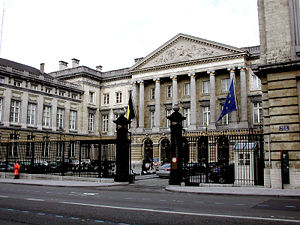
Constitutional structure
Belgium is a constitutional, popular monarchy and a parliamentary democracy.
The Constitution of Belgium was established in 1831, and revised in 1970 in response to conflict between the Dutch-speaking and French-speaking communities, to diffuse power to the communities and the regions. It was revised again in 1993, creating a federal state. The constitution is the primary source of law and the basis of the political system in Belgium.
The King of the Belgians is the constitutional head of the Belgian state and holds office for life. As head of state, the king plays a ceremonial and symbolic role. Following legislative elections, the leader of the majority party or the leader of the majority coalition is usually appointed prime minister by the monarch and then approved by parliament.
The bicameral Parliament consists of a Senate of 71 members, 40 of whom are directly elected by popular vote and 31 indirectly elected, to serve four-year terms, and a Chamber of Deputies of 150 members who are directly elected by popular vote on the basis of proportional representation to serve four-year terms. Suffrage is universal to those aged 18 years and over. Voting is compulsory so more than 90 percent of the population participates.
Belgium is a federation with a multi-party political system, with numerous parties have no chance of gaining power alone, and therefore must work with each other to form coalition governments. Almost all Belgian political parties are divided into linguistic groups, either Dutch-speaking parties, Francophone parties, or germanophone parties. The Flemish parties operate in Flanders and in the Brussels-Capital Region. The Francophone parties operate in Wallonia and in the Brussels-Capital Region. There are also parties operating in the comparatively small German-speaking community.
Political parties are thus organised along community lines, especially for the three main communities. There are no representative parties active in both communities. Even in Brussels, all parties presenting candidates are either Flemish parties, or French-speaking. As such, the internal organisation of the political parties reflects the fundamentally dual nature of Belgian society. There are no significant parties left who exist, or operate on a national, Belgian level.
From the creation of the Belgian state in 1830 and throughout most of the nineteenth century, two political parties dominated Belgian politics: the Catholic Party (Church-oriented and conservative) and the Liberal Party (anti-clerical and progressive). In the late nineteenth century the Labour Party arose to represent the emerging industrial working class.
Belgium is a highly unionised country, and organised labour is a powerful influence in politics. About 53 percent of all private sector and public service employees are labour union members. Not simply a "bread and butter" movement in the American sense, Belgian labour unions take positions on education, public finance, defence spending, environmental protection, women's rights, abortion, and other issues. They also provide a range of services, including the administration of unemployment benefits. Belgium's three principal trade union organizations are the Confederation of Christian Trade Unions (1,705,000 members), the General Federation of Belgian Labour (1,198,000 members) and the General Confederation of Liberal Trade Unions of Belgium which has 230,000 members.
The Court of Appeals is one level below the Court of Cassation, an institution based on the French Court of Cassation. The Court of Cassation is the most important court in Belgium. Judges are appointed for life by the Belgian monarch. The judicial system is based on civil law and originates from the Napoleonic code. It has a judicial review of legislative acts. It accepts compulsory ICJ jurisdiction, with reservations.
Political crisis
A string of Christian Democrat coalition governments from 1958 was broken in 1999 after the first dioxin crisis, a major food contamination scandal which led to the establishment of the Belgian Food Agency. The government led by Prime Minister Guy Verhofstadt from 1999 to 2007 achieved a balanced budget, some tax-reforms, a labour-market reform, scheduled nuclear phase-out, and instigated legislation allowing more stringent war crime and more lenient soft drug usage prosecution. Restrictions on withholding euthanasia were reduced and same-sex marriage legalized. The government promoted active diplomacy in Africa. Verhofstadt's coalition fared badly in the elections of 2007. Since then, as of November 2007, the country has been experiencing a long lasting political crisis. This crisis is such that many observers have speculated a possible partition of Belgium.
In its 2007 Worldwide Press Freedom Index, Reporters Without Borders ranked Belgium (along with Finland and Sweden) 5th out of 169 countries.
Language a political issue
Belgium is a country where language is a major political issue. Despite the numerous constitution revisions, the matter is not completely settled. There is still a lot of political tension between French-speakers and Dutch-speakers, and, to a lesser degree, between French-speakers and the politically far weaker German-speakers. Flemings also complain about remaining discriminations (like the fact Walloon candidates can obtain votes from voters in both Flemish and Walloon regions, but that is impossible for a Flemish candidate).
Political authority
The Federal State retains a considerable "common heritage". This includes justice, defense, federal police, social security, nuclear energy, monetary policy and public debt, and other aspects of public finances. State-owned companies include the Post Office and Belgian Railways. The Federal Government is responsible for the obligations of Belgium and its federalized institutions towards the European Union and NATO. It controls substantial parts of public health, home affairs and foreign affairs.
Communities exercise their authority only within linguistically determined geographical boundaries, originally oriented towards the individuals of a Community's language: culture (including audiovisual media), education, and the use of the relevant language. Extensions to personal matters less directly connected with language comprise health policy (curative and preventive medicine) and assistance to individuals (protection of youth, social welfare, aid to families, immigrant assistance services, etc.).
Regions have authority in fields that can be broadly associated with their territory. These include economy, employment, agriculture, water policy, housing, public works, energy, transport, the environment, town and country planning, nature conservation, credit, and foreign trade. They supervise the provinces, municipalities, and intercommunal utility companies.
In several fields, the different levels each have their own say on specifics. With education, for instance, the autonomy of the Communities neither includes decisions about the compulsory aspect nor allows for setting minimum requirements for awarding qualifications, which remain federal matters.[6] Each level of government can be involved in scientific research and international relations associated with its powers.
Military
The Belgian Armed Forces have about 41,000 active troops. They are organised into one unified structure which consists of four main components: The Army, the Air Force, the Navy, and the Medical Component.
Economy
Belgium's economy and its transportation infrastructure are integrated with the rest of Europe. Its location at the heart of a highly industrialized region helps make it one of the world's ten largest trading nations. The economy is characterized by a highly productive work force, high GNP, and high exports per capita.[7] Belgium's main imports are food products, machinery, rough diamonds, petroleum and petroleum products, chemicals, clothing and accessories, and textiles. Its main exports are automobiles, food and food products, iron and steel, finished diamonds, textiles, plastics, petroleum products, and nonferrous metals. The Belgian economy is heavily service-oriented and shows a dual nature: a dynamic Flemish economy, with Brussels as its main multilingual and multi-ethnic centre, and a Walloon economy that lags behind.[8][9] One of the founding members of the European Union, Belgium strongly supports an open economy and the extension of the powers of EU institutions to integrate member economies. In 1999, Belgium adopted the euro, the single European currency, which fully replaced the Belgian franc in 2002. Since 1922, Belgium and Luxembourg have been a single trade market within a customs and currency union: the Belgium-Luxembourg Economic Union.
Belgium was the first continental European country to undergo the Industrial Revolution, in the early 1800s.[10] Liège and Charleroi rapidly developed mining and steelmaking, which flourished until the mid-20th century. However, by the 1840s the textile industry of Flanders was in severe crisis and the region experienced famine from 1846–50.
After World War II, Ghent and Antwerp experienced a rapid expansion of the chemical and petroleum industries. The 1973 and 1979 oil crises sent the economy into a recession; it was particularly prolonged in Wallonia, where the steel industry had become less competitive and experienced serious decline.[11] In the 1980s and 90s, the economic centre of the country continued to shift northwards and is now concentrated in the populous Flemish Diamond area.[12]
By the end of the 1980s, Belgian macroeconomic policies had resulted in a cumulative government debt of about 120% of GDP. As of 2006, the budget was balanced and public debt was equal to 90.30% of GDP.[13] In 2005 and 2006, real GDP growth rates of 1.5% and 3.0%, respectively, were slightly above the average for the euro area. Unemployment rates of 8.4% in 2005 and 8.2% in 2006 were close to the area average.[14]
It is one of the founding members of the European Union and hosts its headquarters, as well as those of other major international organizations, including NATO.[15]
Demographics
has a population of about 10.5 million.
At the start of 2004 nearly 92% of the Belgian population were national citizens, and around 6% were citizens from other European Union member countries. The prevalent foreign nationals were Italian (183,021), French (114,943), Dutch (100,700), Moroccan (81,763), Spanish (43,802), Turkish (41,336), and German (35,530).[16]
Urbanization
Almost all of the Belgian population is urban - 97% in 2004.[17] Statistics for 1991 indicate two out of three residents were owners of their dwelling in Flanders and Wallonia, compared to 40% in the Brussels-Capital Region.[18] The population density of Belgium is 342 per square kilometre (886 per square mile) – one of the highest in Europe, after that of the Netherlands and some microstates such as Monaco. The most densely inhabited area is the Flemish Diamond, outlined by the Antwerp-Leuven-Brussels-Ghent agglomerations. The Ardennes have the lowest density. As of 2006, the Flemish Region had a population of about 6,078,600, with Antwerp (457,749), Ghent (230,951) and Bruges (117,251) its most populous cities; Wallonia had 3,413,978, with Charleroi (201,373), Liège (185,574) and Namur (107.178) its most populous. Brussels houses 1,018,804 in the Capital Region's 19 municipalities, two of which have over 100,000 residents.[1]
Languages
Both the Dutch spoken in Belgium and the Belgian French have minor differences in vocabulary and semantic nuances from the varieties spoken in the Netherlands and France. Many Flemish people still speak dialects of Dutch in their local environment. Walloon, once the main regional language of Wallonia, is now only understood and spoken occasionally, mostly by elderly people. Its dialects, along with those of Picard,[19] are not used in public life.
As no census exists, there are no official statistics on Belgium's three official languages or their dialects. Various criteria, including the language(s) of parents, of education, or the second-language status of foreign born, may affect suggested figures. An estimated 59%[20] of the Belgian population speaks Dutch (often referred to as Flemish), and French is spoken by 40%. Total Dutch speakers are 6.23 million, concentrated in the northern Flanders region, while French speakers comprise 3.32 million in Wallonia and an estimated 0.87 million or 85% of the officially bilingual Brussels-Capital Region.[21][22] The German-speaking Community is made up of 73,000 people in the east of the Walloon Region; around 10,000 German and 60,000 Belgian nationals are speakers of German. Roughly 23,000 more of German speakers live in municipalities near the official Community.[23][24]
The Capital Region having bilingual status obliges its authorities to attend to people and organisations in French or Dutch language as these prefer, and to show street names in both languages on the plates, but does not allow a bilingual school as education belongs to either the French Community or the Flemish one. Geographically, it is an enclave in the Flemish Region though near Wallonia. Constitutionally, it is a politically distinct Region, while within its boundaries both the Flemish and French Communities exercise their authority. Its local language until shortly before Belgium's independence used to be Dutch, now mainly spoken by approximately 0.15 million residents, or a 15% minority.[25][26][27][21][22] Recent immigration, usually from a neither French nor Dutch-speaking country, has brought its population of foreign origin to 56%; thus the first language of roughly half of the inhabitants is not an official one of the Capital Region. Nevertheless, about three out of four residents have the Belgian nationality.[28][29][30][31] In general the population of Brussels is younger and the gap between rich and poor is wider. Brussels also has a large concentration of Muslims, mostly of Turkish and Moroccan ancestry, and mainly French-speaking black Africans. However, Belgium does not collect statistics by ethnic background, so exact figures are unknown.
In 2006, the UCL, the country's largest French-speaking university, published a report with this introduction (here translated): "This issue of Regards économiques is devoted to the demand for knowledge of languages in Belgium and in its three regions (Brussels, Flanders, Wallonia). The surveys show that Flanders is clearly more multilingual, which is without doubt a wellknown fact, but the difference is considerable : whereas 59% and 53% of the Flemings know French or English respectively, only 19% and 17% of the Walloons know Dutch or English. The measures advocated by the Marshall Plan go towards the proper direction, but are without doubt very insufficient to fully overcome the lag." (This particular 2006–2009 'Marshall Plan' was deviced in 2004 and published in 2005 to uplift the Walloon economy.[32]) Within the report, professors in economics Ginsburgh and Weber further show that of the Brussels' residents, 95% declared they can speak French, 59% Dutch, and 41% know the non-local English. Economically significant for a further globalizing future, among people under the age of forty, in Flanders 59%, in Wallonia 10%, and in Brussels 28% can speak all three forementioned languages. In each region, Belgium's third official language, German, is notably less known than those.[33][34][28]
Education
Education is compulsory from six to eighteen for Belgians, but many continue to study until about 23 years of age. Among OECD countries in 2002, Belgium had the third-highest proportion of 18–21-year-olds enrolled in postsecondary education, at 42%.[35] Though an estimated 98% of the adult population is literate, concern is rising over functional illiteracy.[19][36]
Highly politicized conflicts between freethought and Catholic segments of the population during the 1950s caused a split in educational organization. A secular branch of schooling is controlled by the Community, the province, or the municipality, while religious, mainly Catholic branch education, is organized by religious authorities, although subsidized and supervised by the Community.[37]
Religion
Since independence, Catholicism, counterbalanced by strong freethought movements, has had an important role in Belgium's politics.[38] However Belgium is largely a secular country as the laicist constitution provides for freedom of religion, and the government generally respects this right in practice. Nevertheless, the monarchy has a reputation of deeply-rooted Catholicism. In 1990, for instance, as King constitutionally obliged to sign a law legalizing abortion after it had been passed by both chambers, Baudouin asked the then Christian-Democrat Prime Minister Wilfried Martens to find a way out, causing the Parliament to declare him 'temporarily unfit to reign', with his consent.[39] On the yearly national holiday, the King and Queen and other members of the royal family officially attend Te Deum celebrations.[40]
Symbolically and materially, the Roman Catholic Church remains in a favourable position. Belgium's concept of 'recognized religions'[41] caused a tedious path for Islam to acquire the treatment of Jewish and Protestant religions. While other minority religions, such as Hinduism, do not yet have such status, Buddhism set the first step on this path in 2007.[37][42][43] According to the 2001 Survey and Study of Religion,[44] about 47% of the population identify themselves as belonging to the Catholic Church, while Islam is the second-largest religion at 4%. A 2006 inquiry in Flanders, considered more religious than Wallonia, showed 55% to call themselves religious, and that 36% believe that God created the world.[45]
According to the most recent Eurobarometer Poll 2005,[46] 43% of Belgian citizens responded that "they believe there is a god", whereas 29% answered that "they believe there is some sort of spirit or life force" and 27% that "they do not believe there is any sort of spirit, god, or life force".
Science and technology
Contributions to the development of science and technology have appeared throughout the country's history. The sixteenth century Early Modern flourishing of Western Europe included cartographer Gerardus Mercator, anatomist Andreas Vesalius, herbalist Rembert Dodoens, and mathematician Simon Stevin among the most influential scientists. In the first half of the seventeenth century, the Walloon method of making bar iron found its way to Sweden where it remained in use for more than two hundred and sixty years.
The quickly developed and dense Belgian railroad system caused major companies like Brugeoise et Nivelles (now the BN division of Bombardier) to develop specific technologies, and the economically important very deep coal mining in the course of the First Industrial Revolution has required highly reputed specialized studies for mine engineers.
The end of the nineteenth century and the twentieth saw important Belgian advances in applied and pure science. The chemist Ernest Solvay and the engineer Zenobe Gramme gave their names to the Solvay process and the Gramme dynamo, respectively, in the 1860s. Georges Lemaître is credited with proposing the Big Bang theory of the origin of the universe in 1927. Three Nobel Prizes in Physiology or Medicine were awarded to Belgians: Jules Bordet in 1919, Corneille Heymans in 1938, and Albert Claude and Christian De Duve in 1974. Ilya Prigogine was awarded the Nobel Prize in Chemistry in 1977.[47]
Culture
Belgian cultural life is concentrated within each language community,[8][48][49] and a variety of barriers have made a shared cultural sphere less pronounced. There are no bilingual universities except the Royal Military Academy, no common media, and no single large cultural or scientific organization in which both main communities are represented. Despite its divisions the region corresponding to today's Belgium has seen the flourishing of major artistic movements that have had tremendous influence on European art and culture.
Fine arts
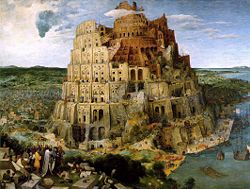
by Pieter Brueghel the Elder,
in Vienna's Kunsthistorisches Museum.
Contributions to painting and architecture have been especially rich. The Mosan art, the Early Netherlandish,[50] the Flemish Renaissance and Baroque painting,[51] and major examples of Romanesque, Gothic, Renaissance and Baroque architecture[52] are milestones in the history of art. Famous names in this classic tradition include the Flemish artists Jan van Eyck, Rogier van der Weyden and, Pieter Brueghel the Elder as well as Lambert Lombard and Theodore de Bry from Liège. The historical artistic production of the Flemish before the early seventeenth century Baroque style of Peter Paul Rubens and Anthony van Dyck is often not distinguished from that of the Dutch. In the southern Netherlands it gradually declined thereafter, although high quality tapestry continued to be created until well into the eighteenth century.[53][54]
During the nineteenth and twentieth centuries many original romantic, expressionist and surrealist Belgian painters emerged, including Egide Wappers, James Ensor, Constant Permeke and René Magritte. The avant-garde CoBrA movement appeared in the 1950s, while the sculptor Panamarenko remains a remarkable figure in contemporary art.[55][56] The multidisciplinary artist Jan Fabre and the painter Luc Tuymans are other internationally renowned figures on the contemporary art scene. Belgian contributions to architecture also continued into the nineteenth and twentieth centuries, including the work of Victor Horta and Henry van de Velde, who were major initiators of the Art Nouveau style.[57][58]
The vocal music of the Franco-Flemish School developed in the southern part of the Low Countries and was an important contribution to Renaissance culture.[59] The nineteenth and twentieth-centuries witnessed the appearance of major violinists, such as Henri Vieuxtemps, Eugène Ysaÿe and Arthur Grumiaux, while Adolphe Sax invented the saxophone in 1846. Belgium has also produced music of contemporary note. The first Belgian singer to successfully pursue an international career is Bobbejaan Schoepen, pioneer of varieté and pop music.[60] Jazz musician Toots Thielemans has achieved global fame, as have the singers Jacques Brel and Italy-born Adamo.[61] In rock/pop music, Telex, Front 242, K's Choice, Hooverphonic, Soulwax and dEUS are well known.[62]
Belgium has produced several well-known authors, including the poet Emile Verhaeren and novelists Hendrik Conscience, Georges Simenon, Suzanne Lilar and Amélie Nothomb. The poet and playwright Maurice Maeterlinck won the Nobel Prize in literature in 1911. The Adventures of Tintin by Hergé is the best known of Franco-Belgian comics, but many other major authors, including Peyo (the smurfs), André Franquin, Edgar P. Jacobs, Marc Sleen, and Willy Vandersteen brought the Belgian cartoon strip industry on a par with the U.S.A. and Japan.
Belgian cinema, often influenced by the Dutch or French, has brought a number of mainly Flemish novels to life on-screen.[63] The absence of a major Belgian cinema company, however, has forced several talented directors to emigrate, such as Carl Colpaert or participate in low-budget productions such as Marc Didden's Brussels by Night (1983).[64] Other Belgian directors include André Delvaux, Stijn Coninx, Luc and Jean-Pierre Dardenne; well-known actors include Jan Decleir and Marie Gillain; and successful films include Man Bites Dog and The Alzheimer Affair.[65] In the 1980s, Antwerp's Royal Academy of Fine Arts produced important fashion trendsetters, known as the Antwerp Six.[66]
Folklore
Folklore plays a major role in Belgium's cultural life: the country has a comparatively high number of processions, cavalcades, 'ommegangs' and 'ducasses',[67] 'kermesse', and other local festivals, nearly always with an originally religious background. The Carnival of Binche with its famous Gilles, and the 'Processional Giants and Dragons' of Ath, Brussels, Dendermonde, Mechelen and Mons are recognized by UNESCO as Masterpieces of the Oral and Intangible Heritage of Humanity.[68] Other examples are the Carnival of Aalst; the still very religious processions of the Holy Blood in Bruges, Virga Jesse in Hasselt, and Hanswijk in Mechelen; the August 15 festival in Liège; and the Walloon festival in Namur. Originated in 1832 and revived in the 1960s, the Gentse Feesten have become a modern tradition. A major non-official holiday is the Saint Nicholas Day, a festivity for children and, in Liège, for students.[69]
Sports
Football and cycling are especially popular amongst Belgians. Eddy Merckx is considered one of the greatest cyclists ever,[70] given five victories of the Tour de France and numerous other bicycle races records; his hour speed record set in 1972 stood for twelve years. Belgium has produced two female tennis champions who repeatedly ranked number one of the world, Kim Clijsters and Justine Henin.
The Spa-Francorchamps motor-racing circuit hosts the Formula One World Championship Belgian Grand Prix. The Belgian driver Jacky Ickx won eight Grands Prix and six 24 Hours of Le Mans, and twice finished as runner-up in the Formula One World Championship. Thierry Boutsen also won three races in 1989 and 1990. Belgium also has a strong reputation in motocross; world champions include Roger De Coster, Joël Robert, Georges Jobé, Eric Geboers, Joël Smets and Stefan Everts.
Belgium has played a major part in the promotion and development of Duathlon. More specifically Benny Vansteelant has made a lasting legacy concquering a stunning 8 World Champion titles and 5 European Champion titles.
Cuisine
Belgium is well known for its cuisine.[71][72] Many highly ranked restaurants can be found in the high-impact gastronomic guides, such as the Michelin Guide.[73] Brands of Belgian chocolate, like Neuhaus, Guylian and Godiva, are world renowned and widely sold. This reputation of very high quality extends to sweets like the 'Caramella Mokatine', created by Confiserie Roodthooft in Antwerp in 1934.[74]
Belgium produces over 500 varieties of beer. The biggest brewery in the world by volume is Inbev based in Belgium.[75] Belgians have a reputation for loving waffles and French fried potatoes, both originated in their country. The national dishes are steak-fries and lettuce, and mussels-fries.[76][77][78] A challenge for a television program caused no less than 307 different Flemish local or regional dishes to be presented on a 118-metre long table in Tivoli Park in Mechelen on 1 September 2007.[79]
ReferencesISBN links support NWE through referral fees
Footnotes
- ↑ 1.0 1.1 Structuur van de bevolking — België / Brussels Hoofdstedelijk Gewest / Vlaams Gewest / Waals Gewest / De 25 bevolkingsrijkste gemeenten (2000–2006) (in Dutch) (asp). Belgian Federal Government Service (ministry) of Economy — Directorate-general Statistics Belgium (© 1998/2007). Retrieved 2007-05-23.
- ↑ Edmundson, George (1922). Chapter II: Habsburg Rule in the Netherlands. History of Holland. The University Press, Cambridge. Republished: Authorama. Retrieved 2007-06-09.
- ↑ Footnote: Further reading: France in the 17th and 18th centuries
- ↑ Kris Deschouwer (January 2004). Ethnic structure, inequality and governance of the public sector in Belgium (pdf). United Nations Research Institute for Social Development (UNRISD). Retrieved 2007-05-22.
- ↑ Meredith, Mark (2005-06-06). The State of Africa, Hardcover 608pp, Free Press, pp. 95–96(?). ISBN 0-7432-3221-6.
- ↑ Cite error: Invalid
<ref>tag; no text was provided for refs namedfedgov1 - ↑ Cite error: Invalid
<ref>tag; no text was provided for refs nameddiplomatbe1 - ↑ 8.0 8.1 Cite error: Invalid
<ref>tag; no text was provided for refs namedFitzmaurice - ↑ Wallonia in 'decline' thanks to politicians. Expatica Communications BV (2005-03-9). Retrieved 2007-06-16.
- ↑ Industrial History Belgium. European Route of Industrial Heritage. Retrieved 2007-05-08.
- ↑ Background Note: Belgium. US Department of State, Bureau of European and Eurasian Affairs (April 2007). Retrieved 2007-05-08.
- ↑ Vanhaverbeke, Wim. Het belang van de Vlaamse Ruit vanuit economisch perspectief The importance of the Flemish Diamond from an economical perspective (in Dutch). Netherlands Institute of Business Organization and Strategy Research, University of Maastricht (Faculty of Economics and Business Administration), The Netherlands. Retrieved 2007-05-19.
- ↑ The World Factbook — (Rank Order — Public debt). CIA (2007-04-17). Retrieved 2007-05-08.
- ↑ Key figures. National Bank of Belgium. Retrieved 2007-05-19.
- ↑ Footnote: Belgium is also a member of, or affiliated to, many international organizations, including ACCT, AfDB, AsDB, Australia Group, Benelux, BIS, CCC, CE, CERN, EAPC, EBRD, EIB, EMU, ESA, EU, FAO, G-10, IAEA, IBRD, ICAO, ICC, ICRM, IDA, IDB, IEA, IFAD, IFC, IFRCS, IHO, ILO, IMF, IMO, IMSO, Intelsat, Interpol, IOC, IOM, ISO, ITU, MONUC (observers), NATO, NEA, NSG, OAS (observer), OECD, OPCW, OSCE, PCA, UN, UNCTAD, UNECE, UNESCO, UNHCR, UNIDO, UNMIK, UNMOGIP, UNRWA, UNTSO, UPU, WADB (non-regional), WEU, WHO, WIPO, WMO, WTrO, ZC.
- ↑ Perrin, Nicolas, UCLouvain, Study Group of Applied Demographics (Gédap) (April 2006). European Migration Network — Annual Statistical Report on migration and asylum in Belgium (Reference year 2003) — section A. 1) b) Population by citizenship & c) Third country nationals, 1 January 2004 (pdf) pp. pages 5–9. Belgian Federal Government Service (ministry) of Interior — Immigration Office. Retrieved 2007-05-28.
- ↑ 5. Demographic trends — Urban population (% of total). Human Development Indicators 2006 — Beyond scarcity: Power, poverty and the global water crisis. United Nations Development Programme (UNDP) (2006). Retrieved 2007-06-06.
- ↑ Quelques résultats des précédents recensements — Indicateurs de logement (1991) (in French switchable to Dutch). Belgian Federal Government Service (ministry) of Economy — Directorate-general Statistics Belgium (© 1998/2007). Retrieved 2007-05-08.
- ↑ 19.0 19.1 Gordon, Raymond G., Jr. (ed.) (2005). Languages of Belgium. Ethnologue: Languages of the World, 15th edition. SIL International Dallas, Texas, USA. Retrieved 2007-05-07.
- ↑ Footnote: Native speakers of Dutch living in Wallonia and of French in Flanders are relatively small minorities which furthermore largely balance one another, hence counting all inhabitants of each unilingual area to the area's language can cause only insignificant inaccuracies (99% can speak the language). Dutch: Flanders' 6.079 million inhabitants and about 15% of Brussels' 1.019 million are 6.23 million or 59.3% of the 10.511 million inhabitants of Belgium (2006); German: 70,400 in the German-speaking Community (which has language facilities for its less than 5% French-speakers), and an estimated 20,000–25,000 speakers of German in the Walloon Region outside the geographical boundaries of their official Community, or 0.9%; French: in the latter area as well as mainly in the rest of Wallonia (3.414 - 0.093 = 3.321 million) and 85% of the Brussels inhabitants (0.866 million) thus 4.187 million or 39.8%; together indeed 100%;
- ↑ 21.0 21.1 Flemish Academic Eric Corijn (initiator of Charta 91), at a colloquium regarding Brussels, on 2001-12-05, states that in Brussels there is 91% of the population speaking French at home, either alone or with another language, and there is about 20% speaking Dutch at home, either alone (9%) or with French (11%) – After ponderation, the repartition can be estimated at between 85 and 90% French-speaking, and the remaining are Dutch-speaking, corresponding to the estimations based on languages chosen in Brussels by citizens for their official documents (ID, driving licenses, weddings, birth, death, and so on); all these statistics on language are also available at Belgian Department of Justice (for weddings, birth, death), Department of Transport (for Driving licenses), Department of Interior (for IDs), because there are no means to know precisely the proportions since Belgium has abolished 'official' linguistic censuses, thus official documents on language choices can only be estimations. For a web source on this topic, see e.g. General online sources: Janssens, Rudi
- ↑ 22.0 22.1 Belgium Market background. British Council. Retrieved 2007-05-05. – Strictly, the capital is the municipality (City of) Brussels, though the Brussels-Capital Region might be intended because of its name and also its other municipalities housing institutions typical for a capital.
- ↑ Cite error: Invalid
<ref>tag; no text was provided for refs namedgermanspeakingcommunity1 - ↑
Citizens from other countries in the German-speaking Community. The German-speaking Commmunity. Retrieved 2007-05-05.
* German (Belgium) — Overview of the language. Mercator, Minority Language Media in the European Union, supported by the European Commission and the University of Wales. Retrieved 2007-05-07.
* Leclerc, Jacques , membre associé du TLFQ (2006-04-19). Belgique • België • Belgien — La Communauté germanophone de Belgique (in French). L'aménagement linguistique dans le monde. Host: Trésor de la langue française au Québec (TLFQ), Université Laval, Quebec. Retrieved 2007-05-07. - ↑ Cite error: Invalid
<ref>tag; no text was provided for refs namedjacquesleclerc1 - ↑ Cite error: Invalid
<ref>tag; no text was provided for refs namedpaulderidder - ↑ Cite error: Invalid
<ref>tag; no text was provided for refs namedsimonpetermann - ↑ 28.0 28.1 Van Parijs, Philippe, Professor of economic and social ethics at the UCLouvain, Visiting Professor at Harvard University and the KULeuven. Belgium's new linguistic challenges. KVS Express (supplement to newspaper De Morgen) March–April 2007: Article from original source (pdf 4.9 MB) pages 34–36 republished by the Belgian Federal Government Service (ministry) of Economy — Directorate-general Statistics Belgium. – The linguistic situation in Belgium (and in particular various estimations of the population speaking French and Dutch in Brussels) is discussed in detail.
- ↑ Van autochtoon naar allochtoon. De Standaard (newspaper) online.
- ↑ Footnote: The Brussels region's 56% residents of foreign origin include several percents of either Dutch people or native speakers of French, thus roughly half of the inhabitants do not speak either French or Dutch as primary language.
- ↑ Population et ménages (in French) (pdf 1.4 MB). IBSA Cellule statistique — Min. Région Bruxelles-Capitale (Statistical cell — Ministry of the Brussels-Capital Region). Retrieved 2007-05-05.
- ↑ Bayenet, Benoît, Professor at the ULB, in 2004 Economical Advisor to the federal Vice Prime Minister & Justice Minister, and to the Walloon Region's Minister of Economy and Employment; Vandendorpe, Luc, Direction Politique économique, Ministry of the Walloon Region (2004). Le plan Marshall: cinq actions prioritaires pour l’avenir wallon (The Marshall plan: five prioritary actions for the Walloon future). OVER.WERK journal of Steunpunt WAV (4/2005).
- ↑ Ginsburgh, Victor, Université Catholique de Louvain; Weber, Shlomo, Professor Economy and Director of the Center for Economic Studies of the Southern Methodist University, Dallas, USA, and having a seat in the expert panel of the IMF [1] (June 2006). La dynamique des langues en Belgique. Regards économiques, Publication préparée par les économistes de l'Université Catholique de Louvain (Numéro 42). (Summary: Slechts 19 procent van de Walen spreekt Nederlands (in Dutch). Nederlandse Taalunie (2006-06-12). Retrieved 2007-05-26. – The article shows the interest in the Ginsburg-Weber report, by the French-language Belgian newspaper Le Soir and the Algemeen Dagblad in the Netherlands)
- ↑ Schoors, Koen, Professor of Economics at Ghent University, the KULeuven and the Vlerick Leuven Gent Management School [2]. Réformer sans tabous - Question 1: les langues — La connaissance des langues en Belgique: Reactie (in Dutch) (pdf). Itinera Institute. Retrieved 2007-06-14. – Reaction on the Ginsburgh-Weber report; Ib. Reactions (in French translation) (pdf).
- ↑ Table 388. Percentage of population enrolled in secondary and postsecondary institutions, by age group and country. Digest of Education Statistics — Tables and Figures. National Center for Education Statistics, Institute of Education Sciences (IES), US Department of Education (2005, data: 2002). Retrieved 2007-06-06.
- ↑ I. Monitoring Human Development: Enlarging peoples's choices... — 5. Human poverty in OECD, Eastern Europe and the CIS (pdf). Human Development Indicators pp. pp. 172–173. United Nations Development Programme (UNDP) (2000). Retrieved 2007-06-06.
- ↑ 37.0 37.1 De Ley, Herman (2000). Humanists and Muslims in Belgian Secular Society (Draft version). Centrum voor Islam in Europe (Centre for Islam in Europe), Ghent University. Retrieved 2007-06-07.
- ↑ See for example Belgium entry of the Catholic Encyclopedia
- ↑ "HEADLINERS; Out of Power", New York Times, 1990-04-08. Retrieved 2007-06-07.
- ↑ Members of the royal family may attend Te Deums at several locations, the King and Queen always in the Brussels-Capital Region.
* July 21 – national holiday. .be Portal. Belgian Federal Government (2004-07-20). Retrieved 2007-07-07.
* Festivities for the National Holiday. .be Portal. Belgian Federal Government (2006-07-14). Retrieved 2007-07-07. - ↑ 2001 Annual Report on Human Rights in Belgium.
- ↑ Bousetta, Hassan; Gsir, Sonia; Jacobs, Dirk (2005). Active Civic Participation of Immigrants in Belgium — Country Report prepared for the European research project POLITIS, Oldenburg (pdf). Carl von Ossietzky University, Oldenburg IBKM. Retrieved 2007-05-08.
- ↑ "België gaat plat op zijn buik voor China (Belgium bends over backwards for China)", Metro (Belgian newspaper), 2007-05-10, pp. page 2. Retrieved 2007-05-10. (written in Dutch) Alternative urls:α, β, pdf 1.1 MB:γ
- ↑ Belgium. International Religious Freedom Report 2004. US Department of State, Bureau of Democracy, Human Rights, and Labor (2004). Retrieved 2007-05-28.
- ↑ Inquiry by 'Vepec', 'Vereniging voor Promotie en Communicatie' (Organisation for Promotion and Communication), published in Knack magazine 22 November2006 p. 14 [The Dutch language term 'gelovig' is in the text translated as 'religious', more precisely it is a very common word for believing in particular in any kind of God in a monotheistic sense, and/or in some afterlife].
- ↑ Eurobarometer on Social Values, Science and technology 2005 - page 11. Retrieved 2007-05-05.
- ↑
Rembert Dodoens: iets over zijn leven en werk — Dodoens' werken (in Dutch). Plantaardigheden — Project Rembert Dodoens (Rembertus Dodonaeus). Stichting Kruidenhoeve/Plantaardigheden, Balkbrug, the Netherlands (Revised 20 Dec, 2005). Retrieved 2007-05-17.
* O'Connor, J. J.; Robertson, E. F. (2004). Simon Stevin. School of Mathematics and Statistics, University of St Andrews, Scotland. Retrieved 2007-05-11.
* Abstract (*). S. Karger AG, Basel. Retrieved 2007-05-11. (*) Free abstract for pay-per-view article by De Broe, Marc E.; De Weerdt, Dirk L.; Ysebaert, Dirk K.; Vercauteren, Sven R.; De Greef, Kathleen E.; De Broe Luc C. (1999). The Low Countries - 16th/17th Century. American Journal of Nephrology 19 (2): pp. 282–9.
* Poh Miller, Carol (Winter 2003). Study Tour Takes A Close-up Look at Sweden’s Industrial Heritage. Society for Industrial Archeology Newsletter 32 (1): p. 7. Department of Social Sciences, Michigan Technological University, U.S.A..
* Midbon, Mark, University of Wisconsin-Madison (2000-03-24). 'A Day Without Yesterday': Georges Lemaitre & the Big Bang pp. pp. 18–19. Commonweal, republished: Catholic Education Resource Center (CERC). Retrieved 2007-06-07. - ↑ Belgium — Arts and cultural education. Compendium of Cultural Policies and Trends in Europe, 8th edition. Council of Europe / ERICarts (2007). Retrieved 2007-05-08.
- ↑ Belgique (though it should have been 'Belgium'). European Culture Portal. European Commission (2007). Retrieved 2007-05-10.
- ↑ Low Countries, 1000–1400 C.E.. Timeline of Art History. Metropolitan Museum of Art (2007). Retrieved 2007-05-10.
- ↑ Low Countries, 1400–1600 C.E.. Timeline of Art History. Metropolitan Museum of Art (2007). Retrieved 2007-05-10.
- ↑ Several examples of major architectural realisations in Belgium belong to UNESCO's World Heritage List: Belgium. Properties inscribed on the World Heritage List. UNESCO. Retrieved 2007-05-15.
- ↑ Low Countries, 1600–1800 C.E.. Timeline of Art History. Metropolitan Museum of Art (2007). Retrieved 2007-05-10.
- ↑ Art History: Flemish School: (1600–1800) — Artists: (biography & artworks). World Wide Arts Resources (2006-02-05). Retrieved 2007-05-10. – A general presentation of the Flemish artistic movement with a list of its artists, linking to their biographies and artworks
- ↑ Belgian Artists: (biographies & artworks). World Wide Arts Resources (2006-02-05). Retrieved 2007-05-10. – List of Belgian painters, linking to their biographies and artworks
- ↑ Baudson, Michel (1996). Panamarenko. Flammarion (Paris), quoted at presentation of the XXIII Bienal Internacional de São Paulo. Retrieved 2007-05-10.
- ↑ Brussels, capital of Art Nouveau (page 1), ib. (page2). Senses Art Nouveau Shop, Brussels (2007). Retrieved 2007-05-11. (for example)
- ↑ Major Town Houses of the Architect Victor Horta (Brussels). UNESCO's World Heritage List. UNESCO. Retrieved 2007-05-16.
- ↑ Western music, the Franco-Flemish school. Encyclopædia Britannica (2007). Retrieved 2007-05-15.
- ↑ Notte, Peter (1992). De Vlaamse kleinkunstbeweging na de Tweede Wereldoorlog. Een historisch overzicht. — 4. De schlager na de tweede wereldoorlog (in Dutch). Verhandeling voorgelegd aan de Faculteit der Letteren en Wijsbegeerte, groep Germaanse Filologie, van de Universiteit Gent, voor het verkrijgen van de graad van licentiaat (Thesis presented at the Faculty of Literature and Philosophy, Germanic Philology, Ghent University, for obtaining a licentiate [equivalent to master's] degree) Promotor: Prof. Dr Anne-Marie Musschoot. Sint-Lodewijkscholen (educational project ethesis). Retrieved 2007-05-12. (For these credentials see this thesis' presentation, retrieved on 2007-05-12)
- ↑ The Italian singer Adamo mainly made his career in Belgium, as confirmed by the biography on his site, retrieved on 2007-06-07.
- ↑ Two comprehensive discussions of rock and pop music in Belgium since the fifties:
* The Timeline — A brief history of Belgian Pop Music. The Belgian Pop & Rock Archives. Flanders Music Centre, Brussels (March 2007). Retrieved 2007-06-07.
* Belgian Culture — Rock. Vanberg & DeWulf Importing (© 2006). Retrieved 2007-05-11. - ↑ Notable Belgian films based on works by Flemish authors include: De Witte (author Ernest Claes) movie by Jan Vanderheyden & Edith Kiel in 1934, remake as De Witte van Sichem directed by Robbe De Hert in 1980; De man die zijn haar kort liet knippen (Johan Daisne) André Delvaux 1965; Mira ('De teleurgang van de Waterhoek' by Stijn Streuvels) Fons Rademakers 1971; Malpertuis (aka The Legend of Doom House) (Jean Ray [pen name of Flemish author who mainly wrote in French, or as John Flanders in Dutch]) Harry Kümel 1971; De loteling (Hendrik Conscience) Roland Verhavert 1974; Dood van een non (Maria Rosseels) Paul Collet & Pierre Drouot 1975; Pallieter (Felix Timmermans) Roland Verhavert 1976; De komst van Joachim Stiller (Hubert Lampo) Harry Kümel 1976; De Leeuw van Vlaanderen (Hendrik Conscience) Hugo Claus (a famous author himself) 1985; Daens ('Pieter Daens' by Louis Paul Boon) Stijn Coninx 1992; see also Filmarchief les DVD!s de la cinémathèque (in Dutch). Retrieved on 2007-06-07.
- ↑ Kroniek van de Vlaamse film 1955–1990 — Perstekst naar aanleiding van de uitgave van ‘Brussels By Night’ (in Dutch) (doc). Flemish Community, Media Desk, Ghent. Retrieved 2007-05-12.
- ↑ A review of the Belgian cinema can be found at Cinema. .be Federal Portal. Federal government of Belgium (2007). Retrieved 2007-05-13.
- ↑ Fashion and the ‘Antwerp Six’. Fashion Worlds, Dorset, UK (© 2004). Retrieved 2007-05-13.
- ↑ Footnote: The Dutch word 'ommegang' is here used in the sense of an entirely or mainly non-religious procession, or the non-religious part thereof – see also its article on the Dutch-language Wikipedia; the Processional Giants of Brussels, Dendermonde and Mechelen mentioned in this paragraph are part of each city's 'ommegang'. The French word 'ducasse' refers also to a procession – see also its article on the French-language Wikipedia; the mentioned Processional Giants of Ath and Mons are part of each city's 'ducasse'.
- ↑ Processional Giants and Dragons in Belgium and France. UNESCO. Retrieved 2007-05-15.
- ↑ Folklore estudiantin liégeois (in French). University of Liège. Retrieved 2007-05-12.
- ↑ Majendie, Matt (2005-04-18). Great, but there are greater (stm). BBC Sport. Retrieved 2007-09-20.
- ↑ Eating Out in Belgium. subsite www.hostelbelgium.com. Hostelworld.com, Dublin, Ireland (2007). Retrieved 2007-05-15.
- ↑ Belgium cuisine. About.com: French Cuisine. About, Inc., a part of The New York Times Company (2007). Retrieved 2007-05-15.
- ↑ The Michelin stars 2007 in Belgium. Resto.be TM Dreaminvest (2007). Retrieved 2007-05-15.
- ↑ Confiserie Roodthooft. Confectionery, Biscuits in Belgium – Belgium Chocolate Directory. WTO Emarketplace. Retrieved 2007-07-08.
- ↑ InBev (2007-04-24). InBev dividend 2006: 0.72 euro per share — infobox: About InBev. Press release. Retrieved on 2007-05-31.
- ↑ Steak-frites. Epicurious. Retrieved 2007-08-12. Republished from Van Waerebeek, Ruth; Robbins, Maria (October 1996). Everybody Eats Well in Belgium Cookbook. Workman Publishing. ISBN 1-56305-411-6 (Paperback), ISBN 0-7611-0106-3 (Cloth).
- ↑ Belgium. Global Gourmet. Retrieved 2007-08-12. Republished from Van Waerebeek, Ruth; Robbins, Maria (October 1996). Everybody Eats Well in Belgium Cookbook. Workman Publishing. ISBN 1-56305-411-6 (Paperback), ISBN 0-7611-0106-3 (Cloth).
- ↑ Mussels. Visit Belgium. Official Site of the Belgian Tourist Office in the Americas (2005). Retrieved 2007-08-12. — Note: Contrarily to what the text suggests, the season starts as early as July and lasts through April.
- ↑ Mechelen viert feest! - het verslag (Fata Morgana) (in Dutch). één, primary TV channel of the official Flemish radio & television broadcast institution VRT (2007-09-02). Retrieved 2007-09-02.. — [300 different ones were required to meet the challenge] see also challenge details, retrieved on 2007-09-02
General online sources
- Belgium. Encyclopædia Britannica Online. Encyclopædia Britannica, Chicago, IL, USA. Retrieved 2007-06-07.
- Boordtabel (in Dutch). Centre for Information, Documentation and Research on Brussels (BRIO) (2007). Retrieved 2007-06-02. (mentioning other original sources)
- CIA World Factbook entry on Belgium Retrieved on 2007-06-07.
- The Constitution. Federal Parliament Belgium (1997-01-21). Retrieved 2007-06-07.
- Country Portal - Europe — Belgium. Belgian Federal Government Service (ministry) of Economy — Directorate-general Statistics Belgium. Retrieved 2007-06-07.
- Fischer, Kathrin (1999-07-21). Die Stellung und Rolle der deutschsprachigen Minderheit in Ostbelgien innerhalb des belgischen Nationalstaats (in German). Kleiner Geländekurs in die EUREGIO Maas-Rhein. Geographical Institute of the Georg-August University (Department Culture and Social Geography), Göttingen, Germany. Retrieved 2007-06-13.
- History of Belgium. World History at KMLA. Korean Minjok Leadership Academy (KMLA) (Last revised 2007-05-30). Retrieved 2007-06-02.
- Janssens, Rudi, Vrije Universiteit Brussel (2001-06-01). Brusselse Thema's 8 — Taalgebruik in Brussel — Taalverhoudingen, taalverschuivingen en taalindentiteit in een meertalige stad (in Dutch, summary The Use of Languages in Brussels pp. 227–250 in English) (pdf) pp. 312 pp. VUBPress, Brussels ISBN 90 5487 293 4 – republished on web site of Centre for Information, Documentation and Research on Brussels (BRIO). Retrieved 2007-06-02.
- Leclerc, Jacques, membre associé du TLFQ (© 2006). Belgique • België • Belgien (in French). L'aménagement linguistique dans le monde. Host: Trésor de la langue française au Québec (TLFQ), Université Laval, Quebec. Retrieved 2007-06-02.
- Mnookin, Robert, Professor at HLS; Verbeke, Alain (2006-12-20). Bye bye Belgium?. International Herald Tribune, republished by Harvard Law School. Retrieved 2007-06-01. – Reflections on nations and nation-state developments regarding Belgium
Bibliography
- Arblaster, Paul (2005-12-23). A History of the Low Countries, Hardcover 312pp, Palgrave Essential Histories, Palgrave Macmillan, New York. ISBN 1-4039-4827-5 [Also edition (2005-12-23), Paperback 312pp, Palgrave Macmillan, New York, ISBN 1-4039-4828-3].
- Blom, J. C. H., Dutch State Institute for War Documentation, ed.; Lamberts, Emiel, Professor in Modern History KULeuven, ed.; Kennedy, James C., translator (May 1999). History of the Low Countries, Hardcover 503pp, Berghahn Books, Oxford/New York. ISBN 1-5718-1084-6 [Also newer edition (2006-06-29), Paperback 516pp, Berghahn Books, New York, ISBN 1-8454-5272-0].
- Cammaerts, Émile L. [1913] (1921). A History of Belgium from the Roman Invasion to the Present Day, 357pp, D. Appleton and Co, New York. OCLC 1525559 ASIN B00085PM0A [Also editions [1913], London, OCLC 29072911; (1921) D. Unwin and Co., New York OCLC 9625246; also published (1921) as Belgium from the Roman invasion to the present day, The Story of the nations, 67, T. Fisher Unwin, London, OCLC 2986704 ASIN B00086AX3A].
- Cook, Bernard A., Professor of History at Loyola University New Orleans, LA, USA (c2002 or May 2004). Belgium: A History, Paperback 205pp, Studies in Modern European History, Vol. 50, Peter Lang Pub, New York. ISBN 0-8204-5824-4 Ib. e-book (2004) NetLibrary, Boulder, CO, USA, ISBN 0-8204-7283-2 [Also print edition (2004-06-30 or 2005), ISBN 0-8204-7647-1].
- de Kavanagh Boulger, Demetrius C. [1902] (2001-06-28 or 2006-03-30). The History of Belgium: Part 1. Cæsar to Waterloo, Paperback 493pp, Elibron Classics, Adamant Media (Delaware corporation), Boston, MA, USA.. ISBN 1-4021-6714-8 [Facsimile reprint of a 1902 edition by the author, London]. – Ib. [1909] (2001-06-28 or 2006-03-30). Ib. Part 2. 1815-1865. Waterloo to the Death of Leopold I, Paperback 462pp, Ib., Ib. ISBN 1-4021-6713-X [Facsimile reprint of a 1909 edition by the author, London].
- Fitzmaurice, John (March 1996). The Politics of Belgium: A Unique Federalism, Paperback 284pp, Nations of the modern world, Westview Press, Boulder, CO, USA. OCLC 30112536. ISBN 0-8133-2386-X.
- Kossmann-Putto, Johanna A.; Kossmann Ernst H.; Deleu Jozef H. M., ed.; Fenoulhet Jane, translator [of: (1987). De Lage Landen : geschiedenis van de Noordelijke en Zuidelijke Nederlanden. Vlaams-Nederlandse Stichting Ons Erfdeel, Rekkem] [1987] (January 1993). The Low Countries: History of the Northern and Southern Netherlands, 3rd Rev. edition Paperback 64pp, Flemish-Netherlands Foundation "Stichting Ons Erfdeel", Rekkem, Belgium. ISBN 9-0708-3120-1 [several editions in English, incl. (1997) 7th ed.].
See also
|
|
|
|
External links
- See also: section References, subsection General online sources
 Wikimedia Atlas of Belgium, holding maps related to Belgium.
Wikimedia Atlas of Belgium, holding maps related to Belgium.- Travel guide to Belgium from Wikitravel
- Belgium, entry on the Catholic Encyclopedia 1913, republished on Wikisource
- Official site of Belgian monarchy
- Official site of the Belgian federal government
- Official Site of the Belgian Tourist Office in the Americas and GlobeScope,
- its links to sites of Belgian Tourist Offices in Belgium
- its links to sites of Belgian Tourist Offices worldwide - History of Belgium: Primary Documents EuroDocs: Online Sources for European History
- Belgium, entry on the Public Diplomacy wiki monitored by the USC Center on Public Diplomacy
- Expatica portal with background information and news on Belgium
Albania · Andorra · Armenia2 · Austria · Azerbaijan1 · Belarus · Belgium · Bosnia and Herzegovina · Bulgaria · Croatia · Cyprus2 · Czech Republic · Denmark3 · Estonia · Finland · France3 · Georgia1 · Germany · Greece · Hungary · Iceland · Ireland · Italy · Kazakhstan1 · Latvia · Liechtenstein · Lithuania · Luxembourg · Republic of Macedonia · Malta · Moldova · Monaco · Montenegro · Netherlands3 · Norway3 · Poland · Portugal · Romania · Russia1 · San Marino · Serbia · Slovakia · Slovenia · Spain3 · Sweden · Switzerland · Turkey1 · Ukraine · United Kingdom3 · Vatican City
1 Has majority of its territory in Asia. 2 Entirely in Asia but having socio-political connections with Europe. 3 Has dependencies or similar territories outside Europe.
Credits
New World Encyclopedia writers and editors rewrote and completed the Wikipedia article in accordance with New World Encyclopedia standards. This article abides by terms of the Creative Commons CC-by-sa 3.0 License (CC-by-sa), which may be used and disseminated with proper attribution. Credit is due under the terms of this license that can reference both the New World Encyclopedia contributors and the selfless volunteer contributors of the Wikimedia Foundation. To cite this article click here for a list of acceptable citing formats.The history of earlier contributions by wikipedians is accessible to researchers here:
The history of this article since it was imported to New World Encyclopedia:
Note: Some restrictions may apply to use of individual images which are separately licensed.
